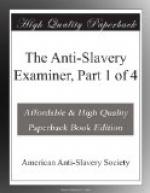But let us see where this principle of the thirty-six will lead us. If “implied faith” to Maryland and Virginia restrains Congress from the abolition of slavery in the District, it requires Congress to do in the District what those states have done within their bounds, i.e., restrain others from abolishing it. Upon the same principle Congress is bound, by the doctrine of Mr. Clay’s resolution, to prohibit emancipation within the District. There is no stopping place for this plighted “faith.” Congress must not only refrain from laying violent hands on slavery, itself, and see to it that the slaveholders themselves do not, but it is bound to keep the system up to the Maryland and Virginia standard of vigor!
Again, if the good faith of Congress to Virginia and Maryland requires that slavery should exist in the District, while it exists in those states, it requires that it should exist there as it exists in those states. If to abolish every form of slavery in the District would violate good faith, to abolish the form existing in those states, and to substitute a totally different one, would also violate it. The Congressional “good faith” is to be kept not only with slavery, but with the Maryland and Virginia systems of slavery. The faith of those states not being in the preservation of a system, but of their system; otherwise Congress, instead of sustaining, would counteract their policy—principles would be brought into action there conflicting with their system, and thus the true spirit of the “implied” pledge would be violated. On this principle, so long as slaves are “chattels personal” in Virginia and Maryland, Congress could not make them real estate, inseparable from the soil, as in Louisiana; nor could it permit slaves to read, nor to worship God according to conscience; nor could it grant them trial by jury, nor legalize marriage; nor require the master to give sufficient food and clothing; nor prohibit the violent sundering of families—because such provisions would conflict with the existing slave laws of Virginia and Maryland, and thus violate the “good faith implied,” &c. So the principle of the resolution binds Congress in all these particulars: 1st. Not to abolish slavery in the District until Virginia and Maryland abolish. 2d. Not to abolish any part of it that exists in those states. 3d. Not to abolish any form or appendage of it still existing in those states. 4th. To abolish when they do. 5th. To increase or abate its rigor when, how, and as the same are modified by those states. In a word, Congressional action in the District is to float passively in the wake of legislative action on the subject in those states.




